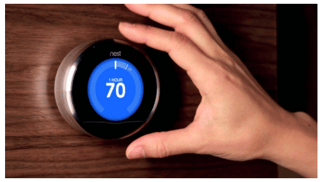This past week, I flew to wonderful Las Vegas, Nevada for the 2015 Gartner AADI (Application Architecture, Development and Integration) Summit. I prepared for the flight by gathering some reading material and a movie, “Terminator Genisys.” The “Genisys” platform in the movie is an operating system that runs on ALL devices, can make decisions, and gets smarter as it’s being used. Sound familiar? The idea stuck with me as I went from presentation to presentation on topics like smart assistants and the future of user experience (UX).
I’ve always been a fan of Terminator movies. Science fiction gives a cool, weird and exciting sense of what could happen in the world. That excitement is partly why I’m in the technology field and passionate about developing technologies that help people. Being able to transform an experience or behavior is a powerful, intimate way to connect with customers.
The ironic drama of the Terminator movies is that our real world technology is catching up to this imagined world. Not only are vendors discussing how to create smart decision engines or how IBM Watson can help fuel better understanding of problems, the Gartner visionaries are very confident that in the near future (3-5 years), digital assistants will become the virtual version of us.
From my conversations and notes from the conference, here are three important takeaways:
Smart Assistants: They will only get smarter
At Summa, we frequently discuss the Customer Engagement approach in which business is well served by the “Know Me” stage of engagement. This approach assumes a mature relationship with the customer (or user) to the point where the customer is comfortable sharing unique information for product customization or better service.
When using Google Now, Siri or Cortana, that experience gets closer and more intimate. Users have conversations and establish trust with the (your) assistant. The ability to learn your personal preferences, really makes the assistant/experience personal to you. That trust and personalization allows more information sharing and an experience that improves the more you use it.
Soon enough, that smart assistant will be able to interface with your watch (maybe it already does) or even your TV. Now API economies are normal, Smart Assistants such as Siri and Cortana are used daily, and the new frontier of Internet of Things (IoT), wearables and context enablement of technology devices is here.
The next evolution past “Know Me” is “Be Me.” The “Be Me” evolution is when you, as a user of a smart assistant (or other technology), give that technology the authority to act as your agent (as you) with little or no input. Soon a smart agent like Siri will be able to pick where you want to eat, respond to a friend’s message or even auto adjust the temperature in your home if your Apple watch senses you have a cold. All of this can happen without user input; “things” are providing the data.
A prediction from Gartner, “By 2020, smart agents will facilitate 40% of mobile interactions.” Do you have the infrastructure, APIs and Software teams involved to enable it with your platform? Have you been thinking about what IoT could mean for you and what “things” could be available to enhance your users’ experiences?
IoT Enablement: More information is better context to solve problems
I mentioned the Apple watch, but many other wearables and “things” are coming to life. I love the Nest thermostat in my home. It constantly and automatically works to reduce costs while making my home more comfortable. It is truly a user experience driven from sensors (things) that I’m wearing, or near.
IoT has become much more than a bunch of makers tinkering with cool ways to measure how much beer is in their fridge. It’s a connected ecosystem of constantly streaming data being analyzed to improve personal experiences. Cloud services collecting the fridge data, the thermostat data, information from a Fitbit or data from a car and applying it to the context is the new opportunity for designers and developers. Maybe your car pings the fridge, sees no beer and autoroutes a trip to the local beer store? Once that trip is completed it adjusts the temperature in your house to a snug 72 degrees for your arrival in 10 minutes. “Things” exposing API’s will, fundamentally, make all of this possible.
Imagine the opportunities for new services and products with such an intimate level of information. This is the IoT. You don’t want to be left without representation. 82% of businesses will have some level of IoT within their organization by 2017. If you don’t have a public API, now is the time to start thinking about them and how they can serve “things” as well as people.
Ambient User Experience: Know Me, and my surroundings… then blend in
This one is not a technology, specifically, but more how understanding technologies working together can be a totally transparent experience. I've heard from a number of designers that the best UI is unnoticed, something that our design team tries to achieve with every project they touch. Well, in this case, you’ll be able to craft an experience that goes completely unseen and unnoticed by human eyes. The design of such an experience will need to be carefully thought through to avoid unwanted side effects.
Imagine a networked alarm system. If you pull the plug to the Internet, will it still function or will it fail? Context of just the device no longer matters, interfacing with daily life will give way to other design opportunities (or challenges). This is part of the ambient experience, especially if there’s a house fire during the Internet outage. The customer/user journey is no longer just within your piece of software, it’s imagining how your software can interact in a fluid, constant, experience with other devices and software in a conversational way. Coherence and Synchronization are usually used for UI discussions, what if the UI is unseen, unheard, unfelt, unnoticed?
Whether these new technologies scare or empower you, we can agree that we’re at an interesting time in technology. Keeping up at this point is the difference between being part of the discussion or not knowing it exists. New models of design and architecture will evolve to work specifically for the “things” around us. This is the first time, in technology, where we will design for the things (machines) we use, not us.
The T-800 (Arnold Schwarzenegger's character) was a self-aware machine that relayed information to “Skynet” in the original, “The Terminator”. My thermostat currently relays all of my HVAC usage to the cloud, adjusts temperature based on my being at home or away. It doesn’t yet stop bullets or analyze threats, but maybe it will soon be able to foresee a winter storm and adjust my home to adapt. Adding a smart assistant with access to API’s from other devices or information sources can only make my experience more personal. I hope the design allows me to teach him, it, them how to smile.




